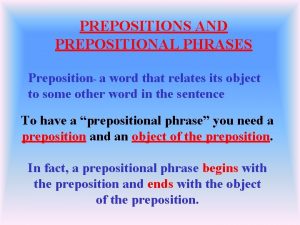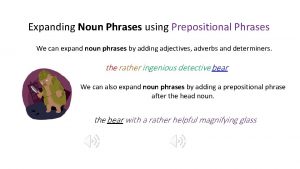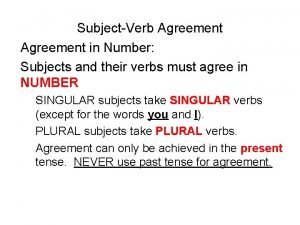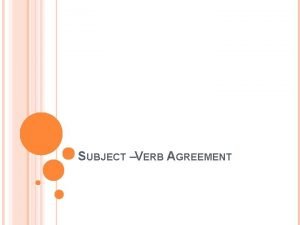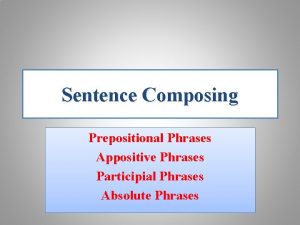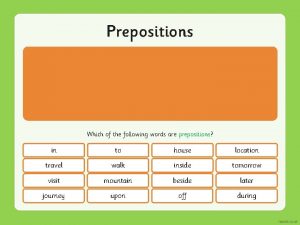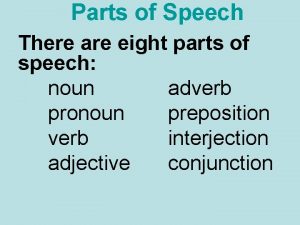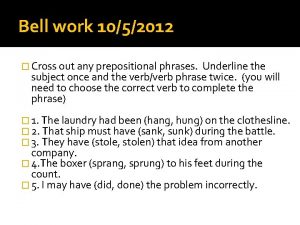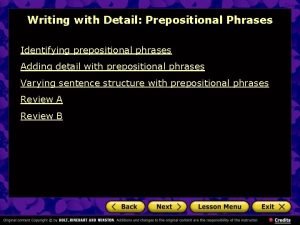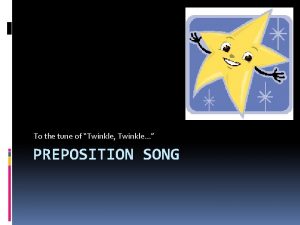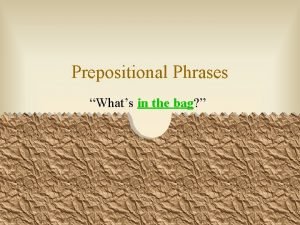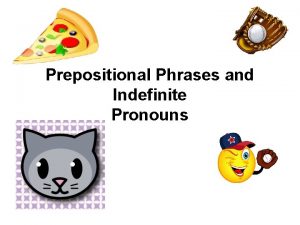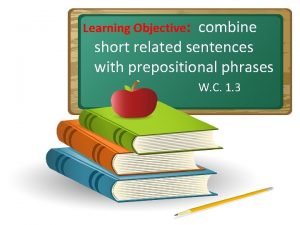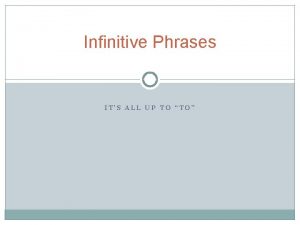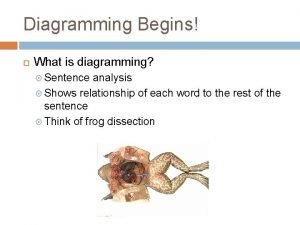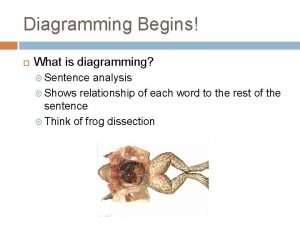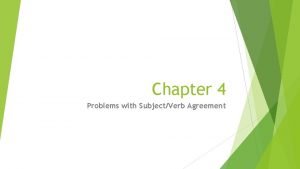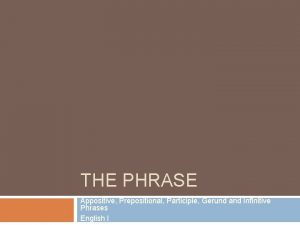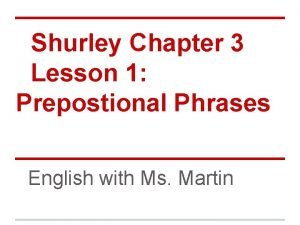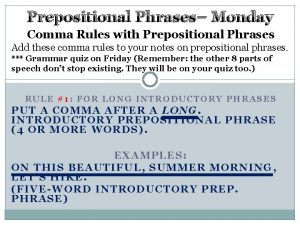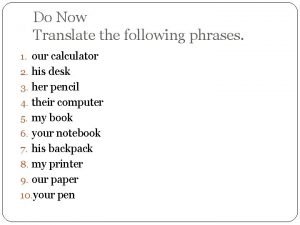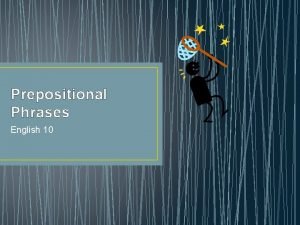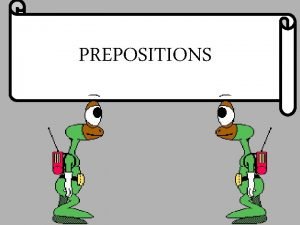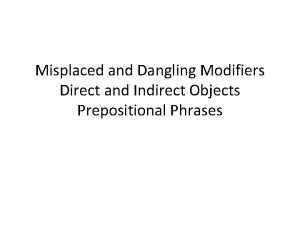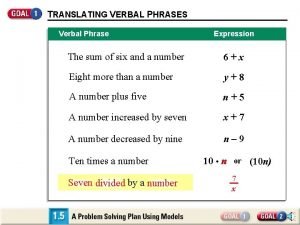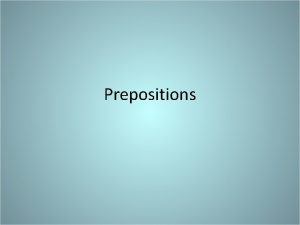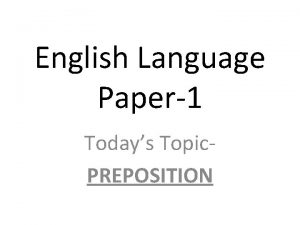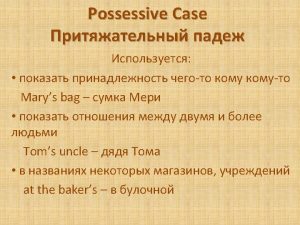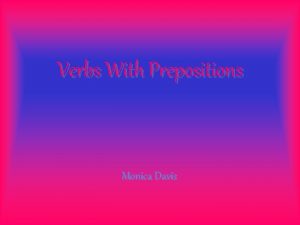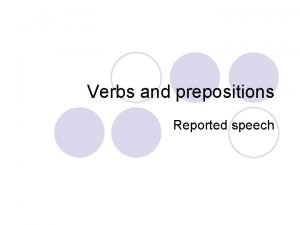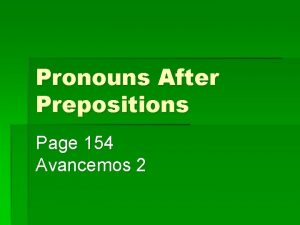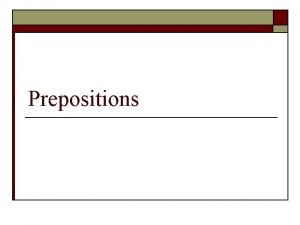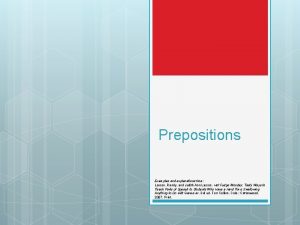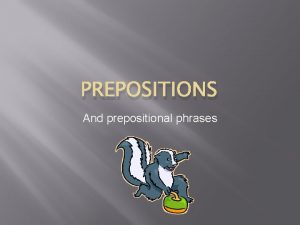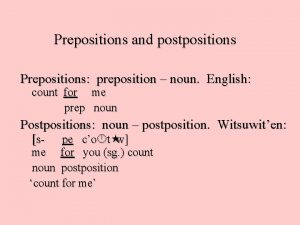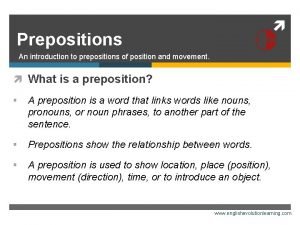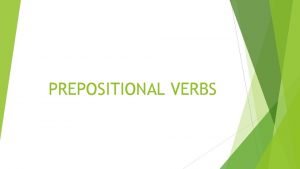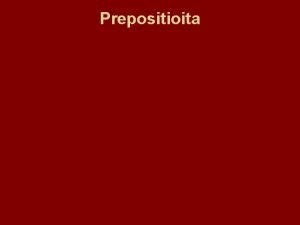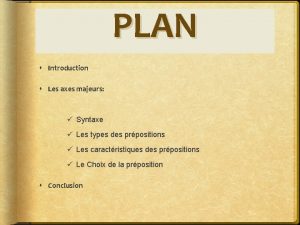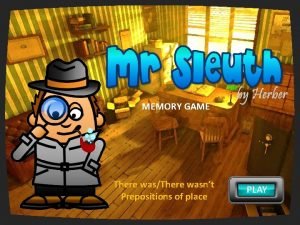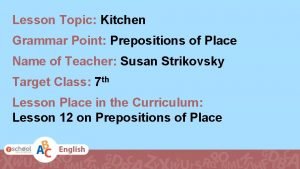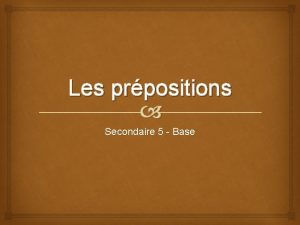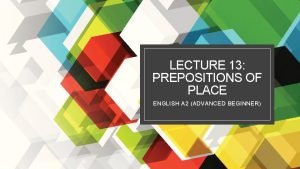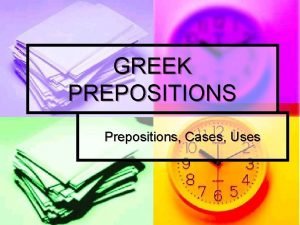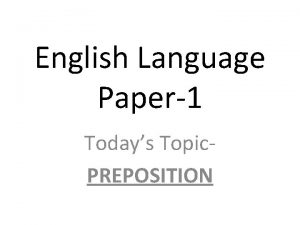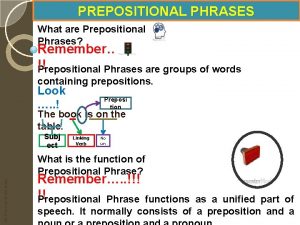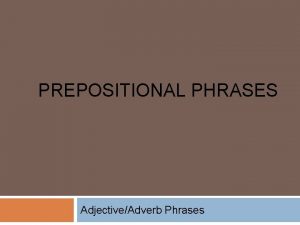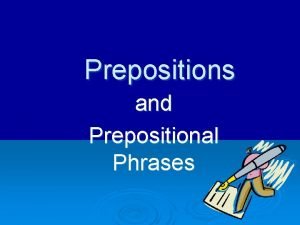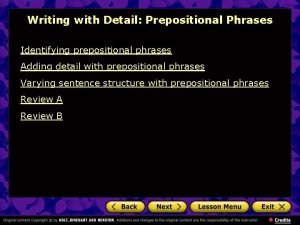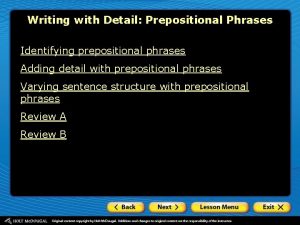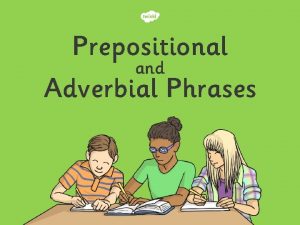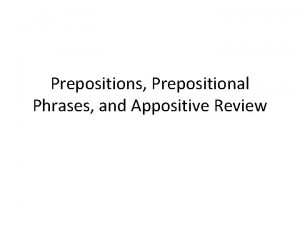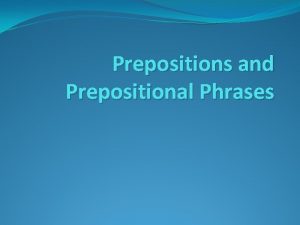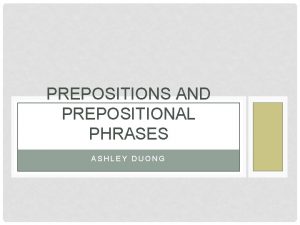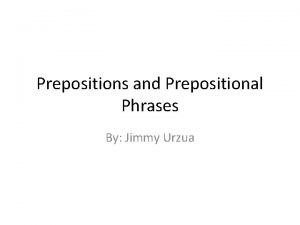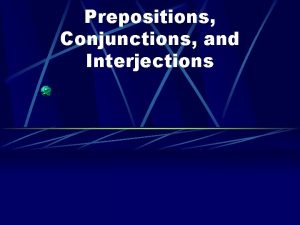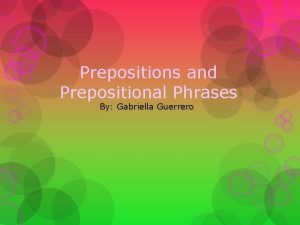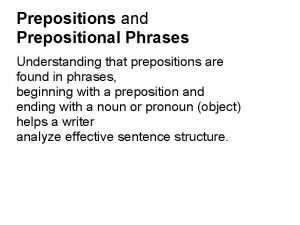Prepositional Phrases Prepositions Preposition is a word that












































































- Slides: 76

Prepositional Phrases

Prepositions Preposition is a word that relates a noun or a pronoun to some other word in a sentence. The paint on the canvas will dry very slowly. The word on is a preposition It shows the relationship of the paint and canvas

Prepositional Phrases A prepositional phrase is a group of words that begins with a preposition and ends with a noun or pronoun – the object of the preposition. Michelangelo was born in a small town. In a small town is a prepositional phrase It starts with a preposition in and ends with a noun town

Frequently Used Prepositions about among beneath except inside off outside underneath above around beside for in spite of on over until according to as of between from instead of on account of past up across at beyond in into onto since upon after because of by in addition to like on top of through with against before by means of in back of near opposite to within ahead of behind down in front of next to out toward without along below during in place of of out of under

What can prepositional phrases tell you? It may tell you where a thing is in relation to something else. The juicy, red apple was on the book.

What can prepositional phrases tell you? It may tell you where a thing is in relation to something else. The juicy, red apple was on the book.

What can prepositional phrases tell you? It may tell you when something is in relation to another event. She refused to leave the house until night.

What can prepositional phrases tell you? It may tell you when something is in relation to another event. She refused to leave the house until night.

What can prepositional phrases tell you? A preposition may tell you the position of something in relation to something else. The gentle, brown dog slept beside the fluffy white rabbit.

What can prepositional phrases tell you? A preposition may tell you the position of something in relation to something else. The gentle, brown dog slept beside the fluffy white rabbit.

What can prepositional phrases tell you? It may also tell you the direction something is travelling in relation to something else. The gallant horseman was riding along the windy shoreline.

What can prepositional phrases tell you? It may also tell you the direction something is travelling in relation to something else. The gallant horseman was riding along the windy shoreline.

You can sometimes begin a sentence with a preposition. Without fear, the brave child climbed the tall mountain.

You can sometimes begin a sentence with a preposition. Without fear, the brave child climbed the tall mountain.

You can sometimes begin a sentence with a preposition. Without fear, the brave child climbed the tall mountain. Under the four poster bed, the lazy cat was having a snooze.

You can sometimes begin a sentence with a preposition. Without fear, the brave child climbed the tall mountain. Under the four poster bed, the lazy cat was having a snooze.

You can sometimes begin a sentence with a preposition. Without fear, the brave child climbed the tall mountain. Under the four poster bed, the lazy cat was having a snooze. Inside the old house, there were all sorts of strange looking people.

You can sometimes begin a sentence with a preposition. Without fear, the brave child climbed the tall mountain. Under the four poster bed, the lazy cat was having a snooze. Inside the old house, there were all sorts of strange looking people.

You can sometimes begin a sentence with a preposition. Without fear, the brave child climbed the tall mountain. Under the four poster bed, the lazy cat was having a snooze. Inside the old house, there were all sorts of strange looking people. Along the hall crawled the large, spindly spider.

You can sometimes begin a sentence with a preposition. Without fear, the brave child climbed the tall mountain. Under the four poster bed, the lazy cat was having a snooze. Inside the old house, there were all sorts of strange looking people. Along the hall crawled the large, spindly spider.

Now you try it! 1. Some artist study Michelangelo’s work for inspiration.

Now you try it! 1. Some artist study Michelangelo’s work for inspiration.

Now you try it! 2. His work had a great influence on many other artists.

Now you try it! 2. His work had a great influence on many other artists.

Now you try it! 3. Artists see perfection in his paintings.

Now you try it! 3. Artists see perfection in his paintings.

Now you try it! 4. They also see it in his sculpture.

Now you try it! 4. They also see it in his sculpture.

Now you try it! 5. Everyone admires the passion he conveyed in his statues.

Now you try it! 5. Everyone admires the passion he conveyed in his statues.

Now you try it! 6. Architects study building designs by Michelangelo.

Now you try it! 6. Architects study building designs by Michelangelo.

Now you try it! 7. Most think him the embodiment of genius.

Now you try it! 7. Most think him the embodiment of genius.

Now you try it! 8. He painted the ceiling of the Sistine Chapel.

Now you try it! 8. He painted the ceiling of the Sistine Chapel.

Now you try it! 9. He lay on his back on a scaffold.

Now you try it! 9. He lay on his back on a scaffold.

Now you try it! 10. The chapel work was completed in three years.

Now you try it! 10. The chapel work was completed in three years.

Independent practice. Complete the worksheet on your own. Use the chart of prepositions as a guide.

Pronouns as Objects of Prepositions Which words are pronouns? he dog was mine the she it their them we you us everybody is her both an many are being

Pronouns as Objects of Prepositions Nick handed the easel to Martha.

Pronouns as Objects of Prepositions Nick handed the easel to Martha. Nick handed the easel to (her, she).

Pronouns as Objects of Prepositions Nick handed the easel to Martha. Nick handed the easel to (her, she). Nick handed the easel to Martha and (her, she).

Pronouns as Objects of Prepositions Nick handed the easel to Martha. Nick handed the easel to (her, she). Nick handed the easel to Martha and (her, she).

I borrowed the palette from Nick and Martha.

I borrowed the palette from Nick and Martha.

I borrowed the palette from Nick and Martha. I borrowed the palette from Nick and (she, her).

I borrowed the palette from Nick and Martha. I borrowed the palette from Nick and (she, her). Lloyd painted with Ayisha and (me, I).

I borrowed the palette from Nick and Martha. I borrowed the palette from Nick and (she, her). Lloyd painted with Ayisha and (me, I).

who and whom Who is never the object of a preposition, only whom. The artist of (who, whom) I spoke has a show at the Whitney Museum.

who and whom Who is never the object of a preposition, only whom. The artist of (who, whom) I spoke has a show at the Whitney Museum. To (whom, who) did you lend the paint brushes?

who and whom Who is never the object of a preposition, only whom. The artist of (who, whom) I spoke has a show at the Whitney Museum. To (whom, who) did you lend the paint brushes?

Practice 1. Nina said that a paper on Rembrandt has been assigned to Bernard and (she, her).

Practice 1. Nina said that a paper on Rembrandt has been assigned to Bernard and (she, her).

Practice 2. Rembrandt is an artist about (who, whom) many historians have written.

Practice 2. Rembrandt is an artist about (who, whom) many historians have written.

Practice 3. According to H. W. Janson and (them, they), Rembrandt’s early work is highly realistic.

Practice 3. According to H. W. Janson and (them, they), Rembrandt’s early work is highly realistic.

Practice 4. Bernard showed some slides to Nina and (I, me).

Practice 4. Bernard showed some slides to Nina and (I, me).

Practice 5. Then I set a series of pictures in front of everyone, including Bernard and (she, her).

Practice 5. Then I set a series of pictures in front of everyone, including Bernard and (she, her).

Practice 6. They all felt familiar with Rembrandt. I asked if they could tell the difference between the artist Caravaggio and (he, him).

Practice 6. They all felt familiar with Rembrandt. I asked if they could tell the difference between the artist Caravaggio and (he, him).

Practice 7. Aside from Bernard, Laticia, and (I, me), no one recognized Rembrandt’s work.

Practice 7. Aside from Bernard, Laticia, and (I, me), no one recognized Rembrandt’s work.

Practice 8. In the seventeenth century, Rembrandt was very popular. Many residents of Amsterdam wanted portraits painted by (him, he).

Practice 8. In the seventeenth century, Rembrandt was very popular. Many residents of Amsterdam wanted portraits painted by (him, he).

Practice 9. Rembrandt painted many life-size portraits of (they, them).

Practice 9. Rembrandt painted many life-size portraits of (they, them).

Practice 10. Rembrandt’s self-portraits were described by Nina and (I, me).

Practice 10. Rembrandt’s self-portraits were described by Nina and (I, me).

Independent practice. Complete the worksheet on your own. Use the chart of prepositions as a guide.

Frequently Used Prepositions about among beneath except inside off outside underneath above around beside for in spite of on over until according to as of between from instead of on account of past up across at beyond in into onto since upon after because of by in addition to like on top of through with against before by means of in back of near opposite to within ahead of behind down in front of next to out toward without along below during in place of of out of under
 What is a preposition phrase
What is a preposition phrase Preposition mean
Preposition mean Expanded noun phrases
Expanded noun phrases Subject object agreement
Subject object agreement Subject verb agreement with prepositional phrases
Subject verb agreement with prepositional phrases Subject verb agreement with prepositional phrases
Subject verb agreement with prepositional phrases Subject verb agreement
Subject verb agreement Participial and prepositional phrases
Participial and prepositional phrases Which of the following is a preposition
Which of the following is a preposition Eight parts of speech
Eight parts of speech Combine phrases
Combine phrases Appositive vs prepositional
Appositive vs prepositional Cross out prepositional phrases
Cross out prepositional phrases Identifying prepositional phrases
Identifying prepositional phrases The preposition song
The preposition song Functions of preposition
Functions of preposition Prepositional phrases brainpop answers
Prepositional phrases brainpop answers Pronouns in prepositional phrases
Pronouns in prepositional phrases Combining sentences with prepositional phrases
Combining sentences with prepositional phrases Infinitive vs prepositional phrase
Infinitive vs prepositional phrase Diagramming relative clauses
Diagramming relative clauses Sentence diagram
Sentence diagram Diagramming complements
Diagramming complements Make verbs agree after expressions of quantity
Make verbs agree after expressions of quantity Unit 13 lesson 3 drivers ed
Unit 13 lesson 3 drivers ed Common prepositional phrases
Common prepositional phrases Infinitive appositive examples
Infinitive appositive examples Agreement with linking verbs
Agreement with linking verbs Lesson 1 prepositional phrases answers
Lesson 1 prepositional phrases answers Prepositional and verbal phrases
Prepositional and verbal phrases Comma after preposition
Comma after preposition Chapter 14: the phrase answer key elements of language
Chapter 14: the phrase answer key elements of language Appositive calculator
Appositive calculator Whats appositive
Whats appositive Look preposition
Look preposition Can a simple sentence have a prepositional phrase
Can a simple sentence have a prepositional phrase Preposition adalah
Preposition adalah Difference between direct and indirect object
Difference between direct and indirect object Lesson 26 adjective clauses answer key
Lesson 26 adjective clauses answer key An appositive phrase is a word group that
An appositive phrase is a word group that Phân độ lown
Phân độ lown Block nhĩ thất độ 1
Block nhĩ thất độ 1 Thể thơ truyền thống
Thể thơ truyền thống Thơ thất ngôn tứ tuyệt đường luật
Thơ thất ngôn tứ tuyệt đường luật Walmart thất bại ở nhật
Walmart thất bại ở nhật Tìm độ lớn thật của tam giác abc
Tìm độ lớn thật của tam giác abc Hãy nói thật ít để làm được nhiều
Hãy nói thật ít để làm được nhiều Tôn thất thuyết là ai
Tôn thất thuyết là ai Gây tê cơ vuông thắt lưng
Gây tê cơ vuông thắt lưng Sau thất bại ở hồ điển triệt
Sau thất bại ở hồ điển triệt Verbal phrases to mathematical phrases examples
Verbal phrases to mathematical phrases examples Is a a preposition
Is a a preposition Examples for preposition
Examples for preposition Typology of word combination
Typology of word combination Read and underline the correct words
Read and underline the correct words Fry phrases
Fry phrases German reflexive verbs with prepositions
German reflexive verbs with prepositions Match these sentences in direct and reported speech
Match these sentences in direct and reported speech I can't stand meaning
I can't stand meaning Spanish pronouns after prepositions
Spanish pronouns after prepositions Prepositions objectives
Prepositions objectives Prepositions function
Prepositions function Unnecessary prepositions examples
Unnecessary prepositions examples Two syllable prepositions
Two syllable prepositions The 49 prepositions
The 49 prepositions Count preposition
Count preposition Introduction to prepositions
Introduction to prepositions Verbs + prepositions list
Verbs + prepositions list Fill in the missing prepositions
Fill in the missing prepositions Les types de prépositions
Les types de prépositions Wasthere
Wasthere Prepositions of place kitchen
Prepositions of place kitchen Les types de prépositions
Les types de prépositions Preposition of person
Preposition of person Greek prepositions pdf
Greek prepositions pdf Grammar rock prepositions
Grammar rock prepositions Kinds of prepositions
Kinds of prepositions
